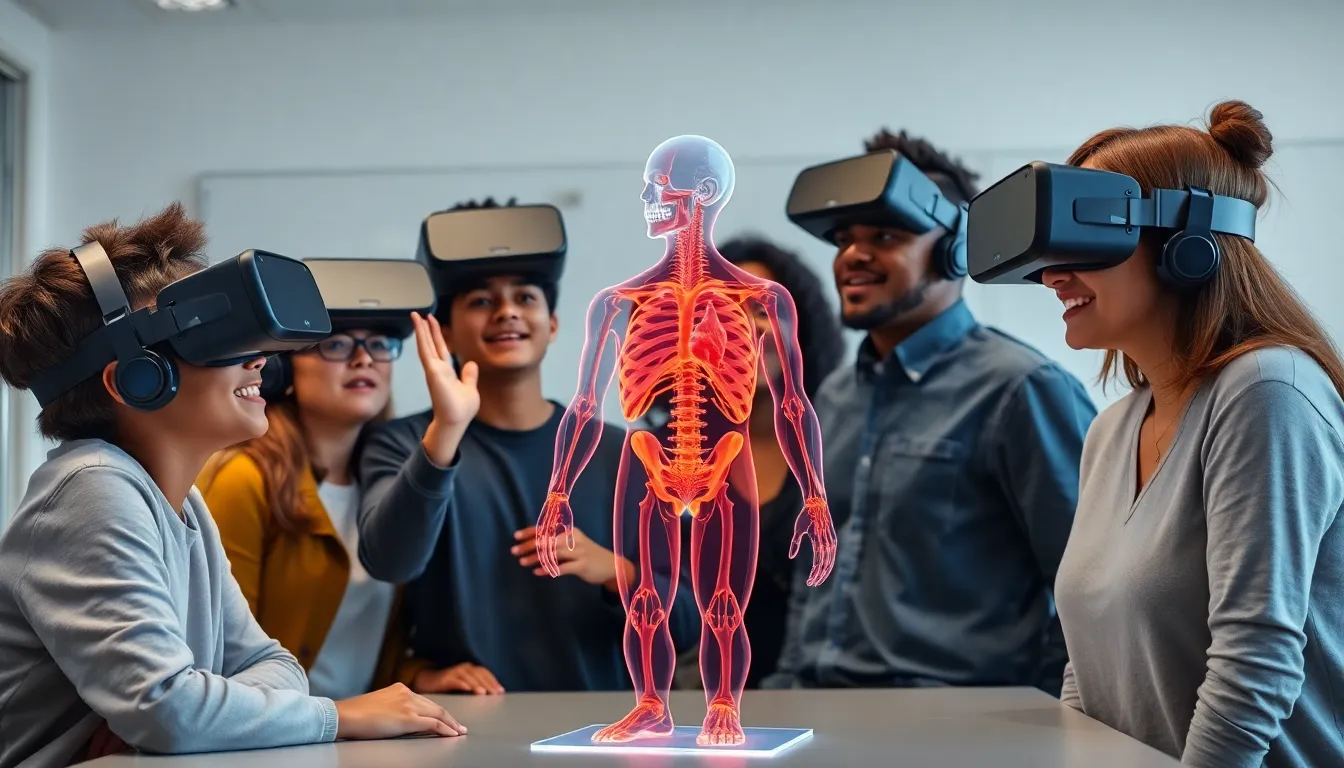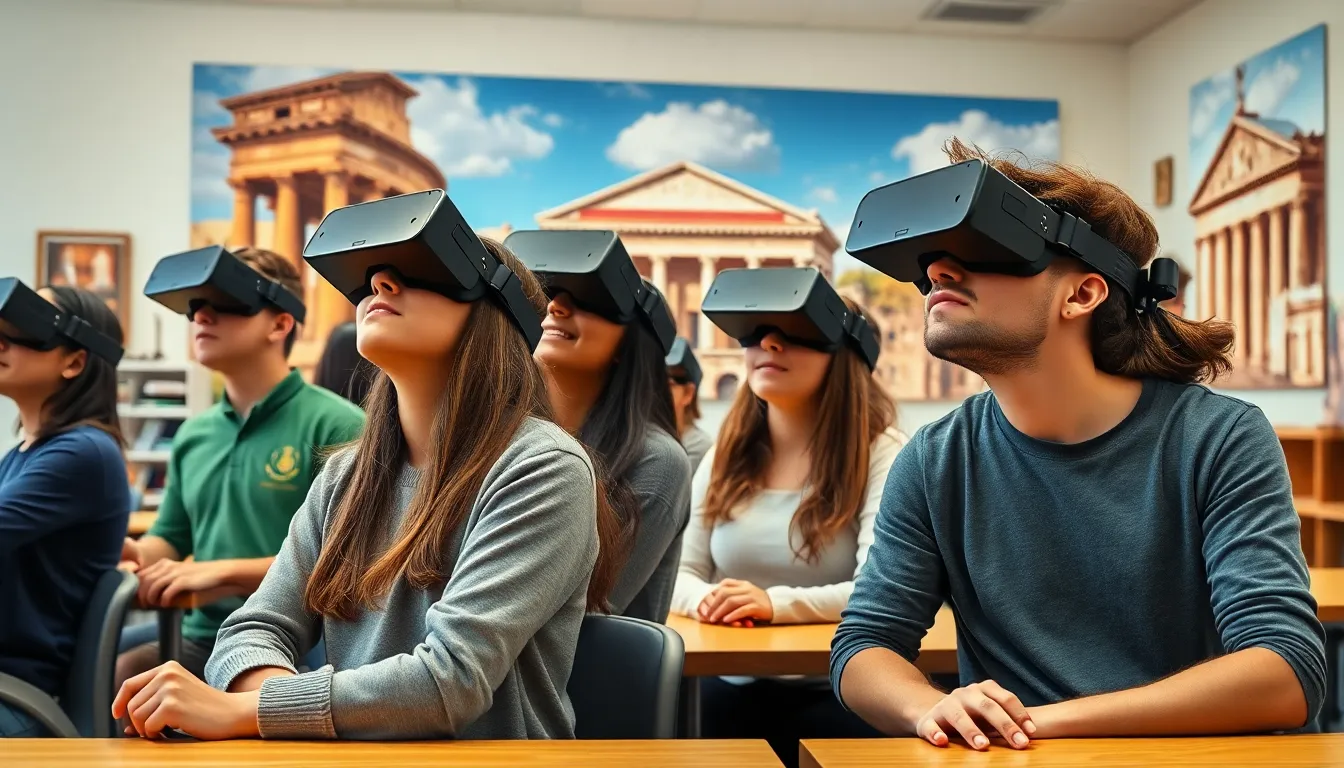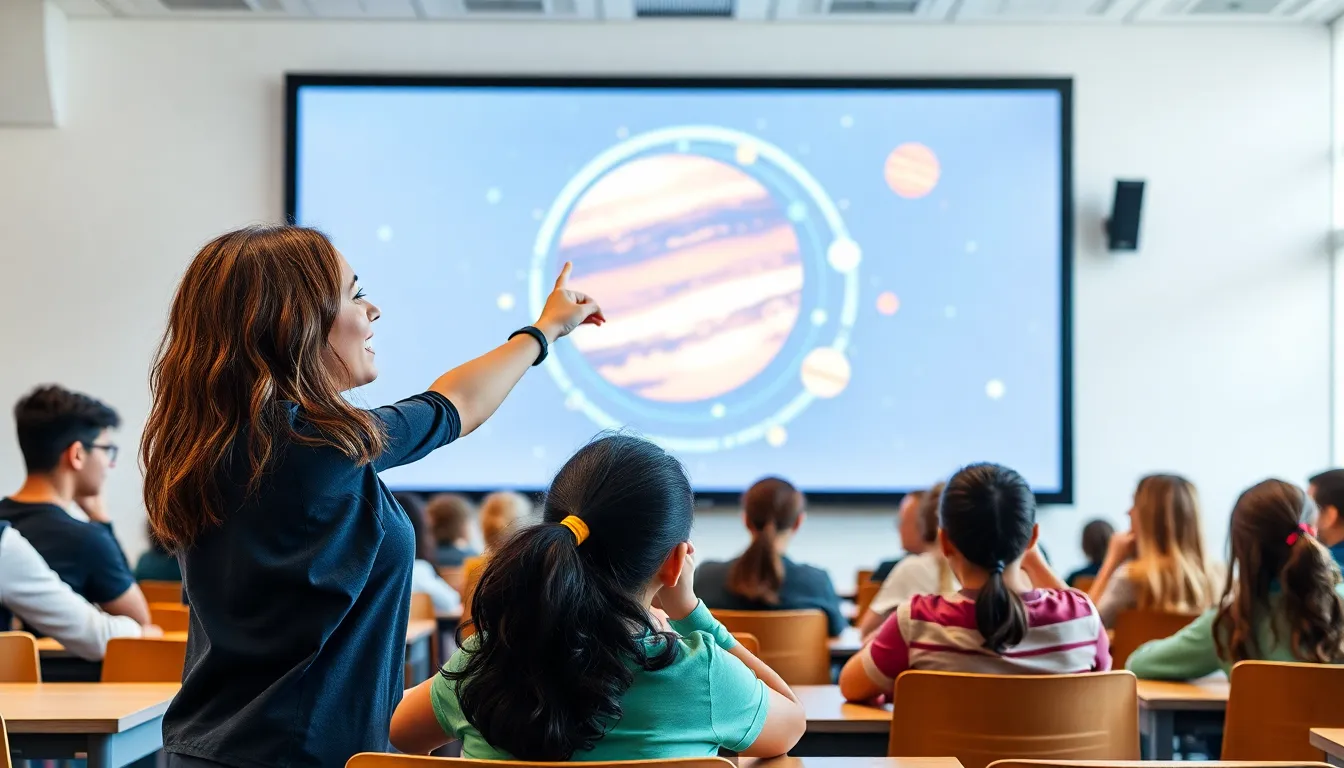Imagine a classroom where students don’t just read about ancient Rome but actually stroll through its bustling streets, dodging chariots and chatting with toga-clad citizens. Welcome to the world of virtual reality in education, where learning leaps off the page and into a vivid, immersive experience. It’s like giving every student a backstage pass to the universe, minus the long lines and overpriced snacks.
Table of Contents
ToggleOverview of Virtual Reality in Education
Virtual reality technology reshapes educational experiences by facilitating immersive learning. Students engage in interactive environments that deepen understanding of complex subjects. Educators utilize VR to transport learners to different settings, enhancing historical contexts such as ancient Rome, providing a sense of presence.
Implementation of virtual reality in classrooms varies across subjects. Science classes benefit from simulations, allowing students to conduct experiments in a safe, controlled space. In art education, VR enables students to explore famous artworks or create digital sculptures without the constraints of physical materials.
The impact of VR extends beyond engagement. Research indicates that learners retain information better when immersed in a virtual environment. A study by PwC found that trainees in VR environments are up to four times more effective in terms of knowledge retention compared to traditional methods.
Accessibility is another consideration. Schools can use VR as an inclusive tool, allowing students with disabilities to access content and experiences they otherwise couldn’t. Multiple platforms accommodate diverse learning styles, making education more equitable.
Integration of VR into the curriculum poses challenges. Funding for VR equipment and training for teachers is often limited. Nevertheless, as more success stories emerge, educational institutions embrace the technology, seeking partnerships with VR firms.
Future trends suggest increased adoption of VR in remote learning. With advancements in technology, educators can reach students beyond geographical boundaries. Virtual reality sits at the forefront of transforming educational landscapes, continually evolving the way knowledge is acquired.
Benefits of Virtual Reality in Education

Virtual reality (VR) transforms education by enhancing immersive experiences for students. This technology allows learners to engage with content interactively, fostering a deeper understanding of complex concepts.
Enhanced Learning Experiences
Immersive learning environments create countless opportunities for exploration. Students can visualize intricate scientific processes, such as human anatomy or chemical reactions, in three dimensions. Historical simulations enable learners to walk through ancient cities, engaging with cultures in ways textbooks cannot replicate. Collaborative VR experiences allow students to work together on projects, encouraging teamwork and communication. Institutions that adopt VR report significant improvements in comprehension and critical thinking skills among students.
Improved Engagement and Motivation
Student motivation increases significantly in immersive settings. Engaging activities capture attention more effectively than traditional lectures. Gamified elements within VR applications stimulate curiosity and a willingness to learn. Students report feeling more connected to the subject matter when they experience it firsthand. As a result, they are more likely to participate actively in discussions and assignments. Research indicates a notable reduction in disengagement, with VR keeping learners focused and enthusiastic about their education.
Challenges of Implementing Virtual Reality in Education
Virtual reality (VR) in education offers exciting opportunities, yet several challenges hinder its effective implementation.
Cost and Accessibility Issues
Funding presents a significant barrier for many schools. Many educational institutions struggle with limited budgets, making it difficult to acquire VR hardware and software. The cost extends beyond purchase, as ongoing maintenance may cause financial strain. Additionally, accessibility has been a concern. While VR can enhance learning experiences, disparities in technology access among students can further widen the educational gap. Schools in underfunded areas may find it especially hard to integrate VR effectively. Affordability issues also restrict the availability of training for educators, impacting their ability to implement VR successfully.
Technical Limitations
Technical challenges impact the effective use of VR in classrooms. Not all schools have reliable internet connections, crucial for many VR applications, leading to interruptions. Hardware limitations can also pose problems. Inadequate devices may not support advanced VR features, resulting in diminished experiences. Furthermore, educators may encounter a steep learning curve while acquiring the skills necessary to utilize VR tools. Compatibility issues between different VR platforms can add to the complexity, causing frustration for both teachers and students. Addressing these technical limitations enhances the potential for VR to transform learning.
Case Studies of Virtual Reality in Education
Virtual reality (VR) significantly enhances educational settings, providing real-world examples of its successful implementation.
Successful Applications in K-12
In K-12 education, numerous schools adopt VR to create immersive learning experiences. Students in a middle school in California engage with a VR platform that transports them to ancient Egyptian pyramids, enriching their history lessons. Another example includes a high school in Texas, where students simulate science experiments in a risk-free virtual lab, improving their understanding of chemistry concepts. Teachers note increased enthusiasm and participation among students using these technologies. Data indicates that standardized test scores improve, showcasing the effectiveness of VR in enhancing academic performance.
Innovative Uses in Higher Education
Higher education institutions also leverage VR for interactive learning. Medical students at a university in New York practice surgical techniques in a completely virtual operating room, gaining hands-on experience without the risks associated with actual procedures. Engineering programs utilize VR to visualize complex designs, helping students develop critical spatial skills. Research shows that students retain information better in these immersive environments. The University of Maryland taps into VR for history courses, allowing students to virtually explore historical landmarks, deepening their understanding and appreciation of the subject matter.
Future Trends in Virtual Reality in Education
Innovations in virtual reality (VR) continue to reshape the landscape of education. Increased adoption in classrooms signals a shift toward immersive learning. Collaboration among technology companies and educational institutions drives accessibility and effectiveness.
Growth in VR content development enhances curriculum integration. Educators can expect a wealth of resources tailored to various subjects, including history and science. Experiential learning becomes more engaging as students visualize complex concepts and historical events.
Increased affordability of VR hardware supports wider implementation. As devices become cost-effective, schools in underfunded areas can also benefit. Moreover, advancements in mobile VR applications make technology accessible for diverse learning environments.
Team-based VR experiences foster social interactions among students. Collaborative projects encourage communication and teamwork, essential skills for modern workplaces. Shared exploration of virtual environments enhances peer learning opportunities.
Customization of VR experiences caters to individual learning styles. Personalized pathways through educational content allow students to learn at their own pace. Adjustments in difficulty and depth of information keep learners engaged and motivated.
Emerging trends indicate VR’s potential in remote learning environments. Distance education benefits from immersive experiences, allowing students to connect with peers and instructors globally. Enhancements in VR technology will also support hybrid learning models.
Research continues to affirm the effectiveness of VR in boosting knowledge retention. A marked increase in information recall among students engaged in VR environments highlights its advantages over traditional methods. Thus, educational institutions are increasingly prioritizing VR integration within their curriculums.
As challenges remain, institutions are exploring partnerships with VR firms to overcome funding and technical barriers. They pursue comprehensive training programs to equip educators with the necessary skills. The future of VR in education appears promising, marked by continual evolution and enhanced learning experiences.
Virtual reality is reshaping the educational landscape by offering innovative ways to engage students and enhance learning outcomes. Its ability to provide immersive experiences not only deepens understanding but also caters to diverse learning needs. As educational institutions continue to embrace VR technology, the potential for improved knowledge retention and collaborative learning expands.
While challenges remain in terms of funding and training, the ongoing development of VR content and hardware promises a more accessible future. By prioritizing VR integration, educators can foster an environment that supports creativity and critical thinking. The journey towards a more interactive and engaging educational experience is just beginning, and the possibilities are truly exciting.



